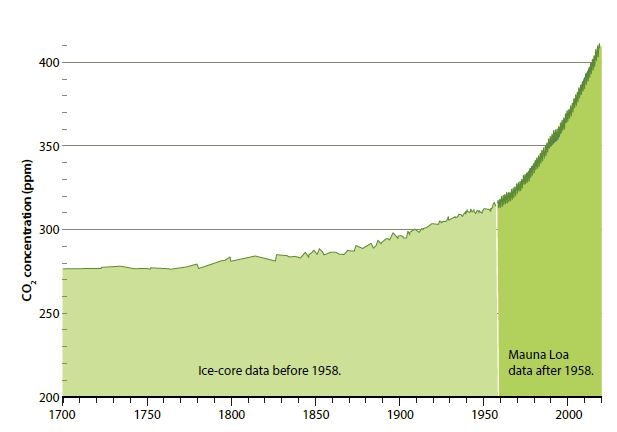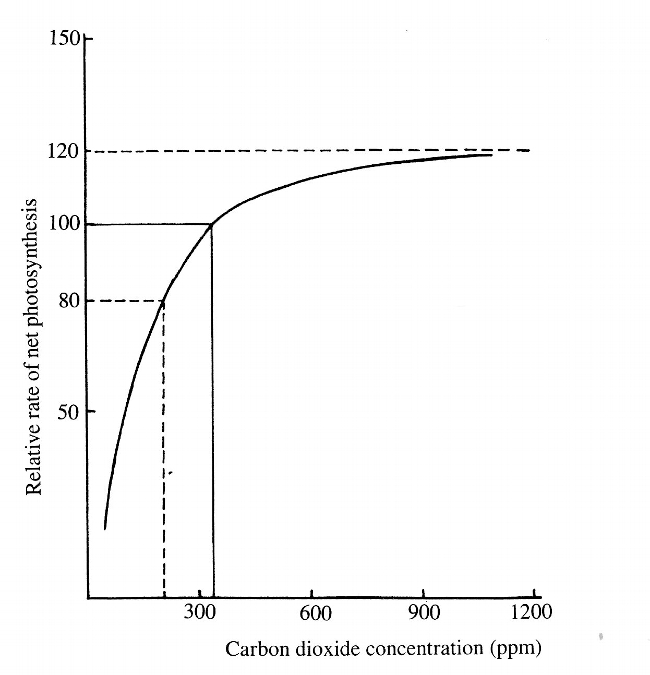Carbon dioxide (CO2) in our atmosphere is dramatically on the rise, and I have experienced it first hand. An article really struck me that I found in the recently published edition of California Agriculture, "Possible Impacts of Rising CO2 on Crop Water Use Efficiency and Food Security" . There in "figure 1" (here inserted on the left) is a graph depicting the carbon dioxide concentration measured from the year 1700 to the present. It was the dramatic acceleration of atmospheric CO2 concentration that occurred during my life time that intrigued me (the darker green portion). According to the "State of the Climate" report in 2017 from the National Oceanic and Atmospheric Administration and the American Meteorological Society, global atmospheric carbon dioxide was 405.0 ± 0.1 ppm in 2017, a new record high.
I measured CO2 in greenhouses and in the atmosphere from about 1985 to 1990 when I evaluated the effectiveness of CO2 enrichment on cut rose productivity and quality in central coast greenhouses. I still have slides (remember them) that indicate the atmospheric CO2 concentration was 340 ppm! This blog post is not about the impact of rising CO2 on global warming (there's a lot of prudent information written about that). It's about the use of CO2 in greenhouse production along the California coast.
So what did our CO2 enrichment evaluation indicate? What is the evidence for or against CO2 enrichment?
First some background. Simply stated, carbon dioxide, water and sunlight is used by plants in the process of photosynthesis to produce sugar and oxygen. The sugar is used by the plant for growth and eventually the flowers and foliage we harvest. Positive responses on flower crops were first reported in the 1960's in Colorado. This first report on flowers and other similar reports from cold-winter climates, made it clear that when the sun was brightly shining in an unvented greenhouse, fast-growing crops were able to deplete the greenhouse CO2 concentration rapidly below the natural ambient CO2 concentration and photosynthesis was significantly reduced. CO2 enrichment to around 1000 ppm produced positive plant responses in many crops.
The figure above is a generalized illustration of how the relative rate of photosynthesis is influenced by greenhouse CO2 concentration. This figure, produced in the 1980s, shows the natural ambient CO2 concentration as 340 ppm. This ambient concentration produces a relative photosynthesis rate of 100%.
But in California, coastal greenhouses are never unvented very long when the sun is shining. Even in winter, CO2 enrichment to 1000 ppm is only possible for just a few hours in early morning and evening when the vents are typically closed. Therefore in our coastal greenhouses it has always been suspected that there would be little benefit to enriching greenhouse air with CO2 using a conventional enrichment method.
In our first experiment (1985-86) the conventional enrichment method was tested: the greenhouse atmosphere was enriched to 1000 ppm only in the morning and evening when the sun was shining and greenhouse vents were shut. The data followed: CO2 enrichment did not improve production or quality of 'Bridal White' cut roses. But some interesting observations directed us to try a different CO2 enrichment method.
CO2 monitors within the rose plant canopy demonstrated that CO2 levels were being depleted to levels as low as 225 ppm during the day, even though vents were opened. Apparently, CO2 was being absorbed quickly by the leaves and greenhouse air was not moving sufficiently into the plant leaf canopy to replenish the CO2 to normal levels (340 ppm). Generally, a drop of CO2 levels below 340 ppm, has a stronger effect on photosynthesis than enrichment above 340 ppm. In fact, the decrease in photosynthesis when carbon dioxide levels drop from 340 to 200 ppm is similar to the increase of photosynthesis when carbon dioxide levels are raised from 340 to about 1300 ppm (again see figure above).
A second experiment was set up (1986 -87) to determine if "all day" carbon dioxide enrichment could improve flower production and quality. This time, carbon dioxide was distributed in drip irrigation tubing running along the ground of each production bed. Liquid CO2 was released as a gas under pressure into the drip tubes when needed. The greenhouse ambient CO2 level was maintained at about 1000 ppm at sunrise until vents were opened and then again if the vents were closed, up to 2 hours before sunset (as in the 1985-86 experiment). In addition, this time when the vents opened, the CO2 level within the plant leaf canopy was maintained around 350 to 360 ppm. This technique eliminated any reduction of CO2 under 350 ppm in the leaf canopy, but did not waste much CO2 since the fresh air around the plant was around 340 ppm and therefore there was no strong diffusion gradient of CO2 away from the plant. Essentially, the carbon dioxide was only being put where it was being used (near the leaves) and applied only when it was needed.
With this method, from summer to the following late spring, CO2 enriched rose production increased by 12% over that of the untreated roses. The rose stem length increased about 1-inch above that of untreated roses. These stems had more girth and appeared robust. Flower bud dry weight was greater, so the flowers may have contained more petals or the petal size was larger. At the time, the CO2 cost was about 18 cents for each extra bud produced. In the heyday of the cut rose business the extra cost may have been worth it, especially during the super profitable Valentine and Mother's Day markets. This all day enrichment experiment was repeated beginning in the fall of 1988 in a different nursery on 'Royalty' cut roses, with similar positive trends forming in the data after six months. But what portended the demise of the cut rose industry in California, the local grower I was working with suddenly decided that production costs needed to go down immediately. Many dramatic changes were made at the nursery, which included the elimination of CO2 enrichment, and consequently my experiment. I wish I had been able to collect more data to make stronger conclusions.
A current literature review indicates similar general findings around the world. Greenhouse vegetable, strawberry and flower crops grown in cold winter climates often improve dramatically with CO2 enrichment but the benefits are limited in areas where climates require high greenhouse ventilation frequencies. See review article below. The most comprehensive "all day" enrichment experiment, similar to the 1986 rose experiments, is an evaluation of summer CO2 enrichment of greenhouse tomatoes in Ontario Canada (2008). In this evaluation, CO2 enrichment to a level above the ambient concentration in summer did not or only slightly increase fruit yield during the three years of the experiment. Marketable fruit yield in August 2005 was actually lower in the CO2 enriched crop; most of these fruits had set and developed in the month of July, a month with the highest solar radiation and air temperatures of the three evaluated summers. (These temperatures probably adversely affected the tomatoes, CO2 assimilation, and muddied the precision of the findings). Summer CO2 enrichment did not affect fruit yield in summer 2006 (a typical weather pattern for the summer season) and slightly increased fruit yield in the summer 2007 (a cooler than usual summer season). They concluded that CO2 enrichment was only valuable when environmental conditions resulted in favorable growing conditions and long enrichment periods. See article below.
The benefit of CO2 enrichment in climates such as along coastal California is limited because it is difficult to achieve higher than ambient CO2 concentrations for significant periods of time when the sun is shining. Under conditions of high solar radiation, the necessary prolonged periods of ventilation will limit the potential for CO2 enrichment. CO2 application methods and crop species will have an impact on the CO2 enrichment benefits also. CO2 delivered directly in and around the leaf canopy has some technical challenges but may have benefits in some crops.
Next: How to maximize photosynthesis with only ambient CO2 .
Attached Files:

